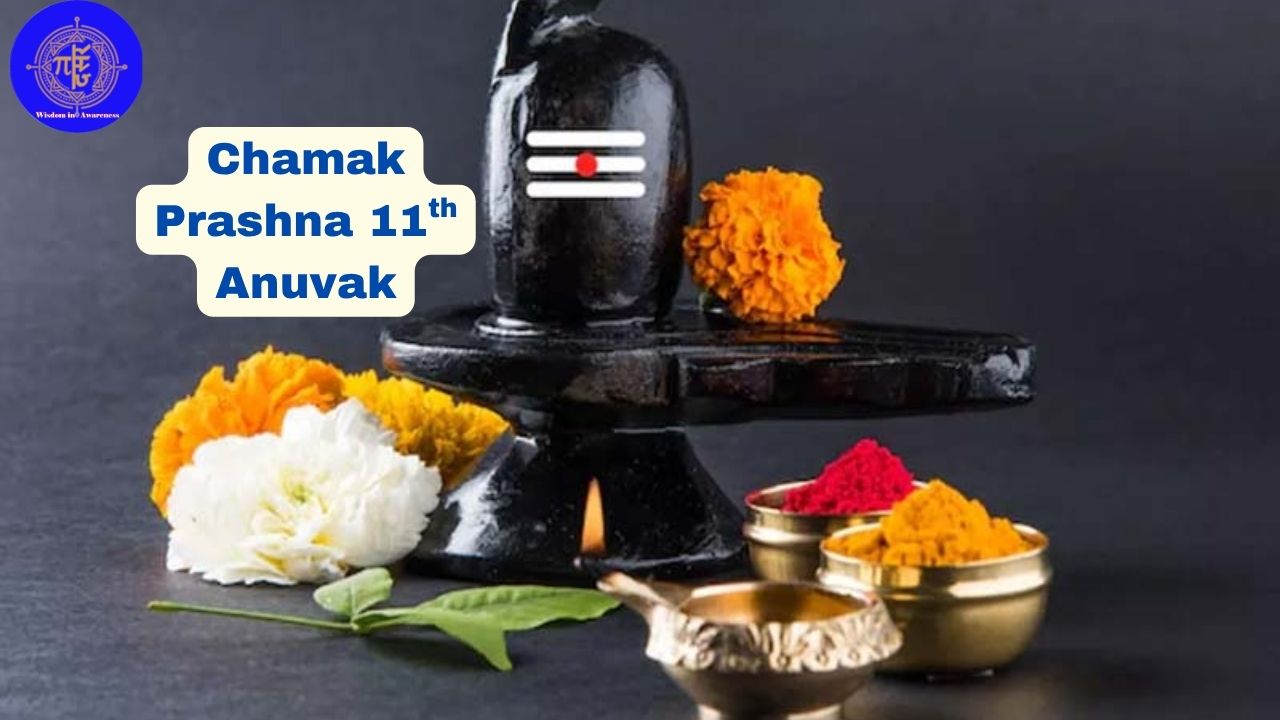
Shri Rudram (श्रीरुद्रम्) is a Vedic mantra or chant dedicated to Rudra, a form of Shiva. It is part of the Krishna Yajurveda’s Taittiriya Samhita (TS 4.5 and 4.7). In the Shukla Yajurveda, it appears in Chapters 16 and 18. Shri Rudram is composed of two sections: the Namakam (also called Rudra Prashna) and the Chamakam (also known as Chamaka Prashna). This text holds great significance in Shaivism, where Shiva is revered as Parabrahman, the Supreme Being.
The Namakam consists of 11 Anuvakas (sections) that seek Lord Shiva’s mercy and grace. The Chamakam, on the other hand, lists the blessings and boons requested from or granted by Lord Shiva.
The following is the 11th Anuvaka of the Chamakam, which consists entirely of numbers. People are often puzzled by what these numbers have to do with prayer. Here, I attempt to offer my interpretation. If you’re seeking more interpretations, I encourage you to explore various schools of thought or consult your own spiritual tradition.
11th Anuvaka of Chamak Prashna#
एका॑ च मे ति॒स्रश्च॑ मे॒ पञ्च॑ च मे स॒प्त च॑ मे॒
नव॑ च म॒ एका॑दश च मे॒ त्रयो॑दश च मे॒ पञ्च॑दश
च मे स॒प्तद॑श च मे॒ नव॑दश च म॒ एक॑विꣳशतिश्च
मे॒ त्रयो॑विꣳशतिश्च मे॒ पञ्च॑विꣳशतिश्च
मे स॒प्तविꣳ॑शतिश्च मे॒ नव॑विꣳशतिश्च
म॒ एक॑त्रिꣳशच्च मे॒ त्रय॑स्त्रिꣳशच्च मे॒
चत॑स्रश्च मे॒ऽष्टौ च॑ मे॒ द्वाद॑श च मे॒ षोड॑श
च मे विꣳश॒तिश्च॑ मे॒ चतु॑र्विꣳशतिश्च
मे॒ऽष्टाविꣳ॑शतिश्च मे॒ द्वात्रिꣳ॑शच्च
मे॒ षट्त्रिꣳ॑शच्च मे चत्वरि॒ꣳ॒शच्च॑ मे॒
चतु॑श्चत्वारिꣳशच्च मे॒ऽष्टाच॑त्वारिꣳशच्च मे॒
वाज॑श्च प्रस॒वश्चा॑पि॒जश्च॒ क्रतु॑श्च॒ सुव॑श्च
मू॒र्धा च॒ व्यश्नि॑यश्चान्त्याय॒नश्चान्त्य॑श्च
भौव॒नश्च॒ भुव॑न॒श्चाधि॑पतिश्च ॥ ११॥
Numbers in Chamakprashna 11th Anuvaka#
Note: च मे means ‘and to me’
Odd Numbers#
- 1 > एका॑ च मे
- 3 > ति॒स्रश्च॑ मे॒
- 5 > पञ्च॑ च मे
- 7 > स॒प्त च॑ मे॒
- 9 > नव॑ च म॒
- 11 > एका॑दश च मे॒
- 13 > त्रयो॑दश च मे॒
- 15 > पञ्च॑दश च मे
- 17 > स॒प्तद॑श च मे॒
- 19 > नव॑दश च म॒
- 21 > एक॑विꣳशतिश्च मे॒
- 23 > त्रयो॑विꣳशतिश्च मे॒
- 25 > पञ्च॑विꣳशतिश्च मे
- 27 > स॒प्तविꣳ॑शतिश्च मे॒
- 29 > नव॑विꣳशतिश्च
- 31 > म॒ एक॑त्रिꣳशच्च मे॒
- 33 > त्रय॑स्त्रिꣳशच्च मे॒
Even Numbers#
- 4 > चत॑स्रश्च मे॒
- 8 > ऽष्टौ च॑ मे॒
- 12 > द्वाद॑श च मे॒
- 16 > षोड॑श च मे
- 20 > विꣳश॒तिश्च॑ मे॒
- 24 > चतु॑र्विꣳशतिश्च मे॒
- 28 > ऽष्टाविꣳ॑शतिश्च मे॒
- 32 > द्वात्रिꣳ॑शच्च मे॒
- 36 > षट्त्रिꣳ॑शच्च मे
- 40 > चत्वरि॒ꣳ॒शच्च॑ मे॒
- 44 > चतु॑श्चत्वारिꣳशच्च मे॒
- 48 > ऽष्टाच॑त्वारिꣳशच्च मे॒
Significance of odd numbers in Hinduism#
Odd Numbers In Hinduism odd numbers reflect dynamism, a worldview where mathematics, cosmology, and spirituality are interconnected. In Hinduism, numbers are not arbitrary — they represent energies, principles, or cosmic functions. Odd numbers are representation of Ishwara, self, wisdom, consciousness, knowledge, Devas etc. So you will find a common these in these numbers.
- One (1): Symbolizes the absolute or Brahman — the indivisible, ultimate reality. Also represents unity and singularity of the Self (Atman).
- Three (3): The Trimurti — Brahma (creation), Vishnu (preservation), Shiva (destruction). Also, body-mind-spirit or the three gunas: sattva, rajas, tamas.
- Five (5): The Pancha Mahabhuta (five great elements) — earth, water, fire, air, space. Also, five senses and five offerings in rituals. Panch Kosha.
- Seven (7): Highly sacred. Refers to the Sapta Rishi (seven sages), Sapta Lokas (seven worlds), and Sapta Swaras (seven musical notes). Also seven steps in marriage (Saptapadi), 7 Chakras, Sapta-Dhaatu
- Nine (9): Symbol of completeness. Associated with Navaratri (nine nights of Goddess worship), Navagrahas (nine planets).
- Eleven (11): Refers to the Ekadasha Rudra (11 forms of Shiva). Ekadashi (11th day of lunar fortnight) is a highly significant fasting day. Ekadashi is associated with Vishnu.
- Thirteen (13): While often seen as inauspicious in the West, in Hindu rituals the 13th day (Trayodashi or Pradosha) is associated with certain death rituals (e.g., Shraddha ceremonies after a person’s death). It is associated with Shiva.
- Fifteen (15): Number of tithis (lunar days) in a fortnight. Krishna Paksha (waning) and Shukla Paksha (waxing) together make a month of 30 tithis (15 + 15). Paurnima is realted to Gauri and Amavasya is related to Kaali.
- Seventeen (17): I need more input on this. May be some Mantra meter.
- Nineteen (19): I need more input on this. May be some Mantra meter.
- Twenty-One (21): Sacred number used in offerings — for instance, 21 modaks to Lord Ganesha. Often used in archanas (rituals of offering names).
- Twenty-Three (23): I need more input on this. May be some Mantra meter.
- Twenty-Five (25): Associated with the Tattvas in Shaivism and Samkhya philosophy — the 25 principles of existence (e.g., Purusha + 24 elements of prakriti).
- Twenty-Seven (27): The 27 Nakshatras (lunar constellations) in Vedic astrology. Also, the 27 yoginis in Tantra.
- Twenty-Nine (29): Lunar calendar months has 29.5 days.
- Thirty-One (31): I need more input on this. May be some Mantra meter.
- Thirty-Three (33): Refers to the 33 Devas mentioned in the Vedas: 8 Vasus, 11 Rudras, 12 Adityas, and 2 Ashvins. Represents the cosmic order.
Significance of even numbers in Hinduism#
Even numbers in Hinduism are more associated with stability, balance, cycles of time, ritual structure, and cosmic frameworks. They show up in formal aspects of worship, philosophical systems (like tattvas), and calendar cycles. These numbers represents world outside, sansara, duality, power, wealth, Asura etc.
Four (4):
- The Vedas (Rig, Yajur, Sama, Atharva)
- The Purusharthas (Dharma, Artha, Kama, Moksha)
- The Yugas (Satya, Treta, Dvapara, Kali)
- The four directions (N, S, E, W) → Symbol of cosmic completeness and order
Eight (8):
- The Ashta Lakshmi (8 forms of Goddess Lakshmi)
- The Ashta Dikpalas (guardians of 8 directions)
- Ashta Siddhis (8 yogic powers) → Represents prosperity, power, protection
Twelve (12):
- 12 Adityas (solar deities)
- 12 Jyotirlingas (sacred Shiva shrines)
- 12 months of the Vedic calendar → Symbol of divine solar energy, time cycle
Sixteen (16):
- Shodasha Upacharas – 16 types of offerings to a deity in Puja
- The Shodashi form of Tripura Sundari (in Tantra)
- Age 16 symbolizes fullness of youth and potential → Associated with beauty, devotion, completeness
Twenty (20):
- Represents full measure, e.g., 10 fingers + 10 toes
- Used in ritualistic counts and groupings of mantras or offerings → Symbol of totality in physical form
Twenty-Four (24):
- The 24 Tattvas in Samkhya philosophy (excluding Purusha)
- 24 letters in the Gayatri Mantra (primary form) → Deep philosophical significance; foundation of creation
Twenty-Eight (28):
- Associated with 28 Nakshatras (when Abhijit is included)
- 28 Yoginis in some tantric texts → Symbol of time cycles and mystical feminine energy
Thirty-Two (32):
- 32 marks (lakshanas) of a great man (Mahapurusha Lakshana)
- Lord Buddha and Vishnu are often said to have these traits. It represents divine perfection
Thirty-Six (36):
- 36 Tattvas in Kashmir Shaivism. A full map of reality from Shiva to matter. It symbolizes cosmic evolution and structure
Forty (40):
- Less directly symbolized, but may be used in extended ritual cycles
Forty-Four (44):
- I need more input on this. Might symbolize duality (2×22) or balance between inner and outer
Forty-Eight (48):
- Can represent extended ritual periods (e.g., 48-day observances)
- Occurs in temple consecration ceremonies and vow durations. Symbol of dedication, perseverance, devotion
Is there any pattern or anything more in these numbers?#
You can play around these number with different functions like square, add, sub, or more more complex functions like shift, sine of radian etc. And let me know did you find anything more intriguing behind these numbers in Chamakprashana.
| Odd | Even | Sub = Even-Odd | Final = Sub - Odd |
|---|---|---|---|
| 1 | 4 | 3 | 2 |
| 3 | 8 | 5 | 2 |
| 5 | 12 | 7 | 2 |
| 7 | 16 | 9 | 2 |
| 9 | 20 | 11 | 2 |
| 11 | 24 | 13 | 2 |
| 13 | 28 | 15 | 2 |
| 15 | 32 | 17 | 2 |
| 17 | 36 | 19 | 2 |
| 19 | 40 | 21 | 2 |
| 21 | 44 | 23 | 2 |
| 23 | 48 | 25 | 2 |
| 25 | |||
| 27 | |||
| 29 | |||
| 31 | |||
| 33 |


Comments: